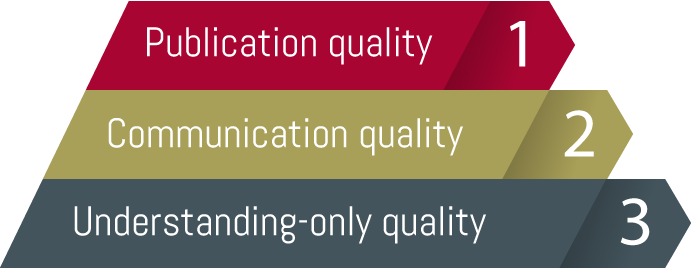A matter of cost, time and image
Quality is no doubt a priority for you when it comes to translation, but would you be able to explain precisely what it means?
According to a survey of the translation industry conducted by PwC Canada, clients typically don’t consider quality a differentiator among translation providers. Why not? Because they expect the same quality from all language services providers. So in their view, there’s no need to define translation quality.
To be clear, we’re not just referring to typos and spelling mistakes. Far from it. We’re referring to accuracy and how successfully a translation fulfills the intended business and communication objectives.
The fact of the matter is that overall quality varies hugely from one language partner to another, and can even differ from one project to the next with the same language partner. Quality—high or low—directly impacts costs, timelines, the effectiveness of your messages and the strength of your brand. It is definitely something to think about.
Giving due consideration to quality is all the more important because, in translation, the concept itself and quality criteria are changing significantly. For decades, quality had one definition. Now there are multiple levels of quality, each with its own definition and meeting specific needs. In short, there is no longer a single, universal definition. That may seem surprising, but it’s par for the course given how communications and communication media are evolving globally.
Read on to see why quality is changing, learn the various possible definitions of quality and discover what Versacom considers the ideal approach.

Evolving quality criteria
Before the digital era, print communications, often for mass distribution, reigned supreme. They had a shelf life of years and, for that reason, had to be of the very highest quality. That level of quality was imperative to prevent delays, cost overruns, and tarnished reputations or other unwanted repercussions as a result of errors.
In a world where communications are exploding and becoming endlessly diverse, this single level of quality is no longer possible, nor is it necessary. Volumes are surging, we are faced with a growing range of scenarios, there is far less time for the translation process and budgetary challenges are unprecedented. The lifespan and visibility of content can also vary tremendously.
This is why various levels of quality are now offered. Each level allows you to achieve specific objectives, based on how strategic the content is for your organization. Each level entails costs and timelines that correspond to the amount of work and the degree of specialization required. Like translation itself, quality transcends mere communication; it’s also a question of operational, financial and overall business efficiency.
Three main quality levels

Top level
This level of quality applies to internal and external documents for mass distribution or of critical importance to the organization and its brand image. This is the highest level of quality expected from your language partner for documents with a substantial impact on communication, business or operational matters.
CONTENT TYPES
- Website or portal
- Contract
- Annual report
- Official speech
- Advertising
- External sponsorship material
- Brand management standards
- User guide for customers
APPROACH
- Translation and revision are assigned to highly experienced language professionals on your dedicated team with the best expertise in the relevant field
- In many cases, the translation is given more than one revision by language professionals with additional industry expertise and stylistic skills
- Translation-assistance tools are used if the text comprises passages previously translated in other documents or that are likely to reappear in part or in full in future documents
COSTS AND TIMELINES
- Ideally, the work is billed by the hour to take into account the exact amount of time your partner has dedicated to achieving the established quality level and objectives
- While the Publication quality level requires the most time overall, a serious, large, professional provider can offer it to you and still meet your tight deadlines, e.g. in the case of an emergency or crisis situation
Mid-level
This level of quality applies to internal documents used in an organization’s day-to-day operations. This level achieves the effectiveness needed for documents concerning important, but not critical matters.
CONTENT TYPES
- Periodic email to a group of employees
- Internal presentation of a wellness program
- Internal recycling policy
- Committee meeting minutes
- Reminder about an occupational health and safety matter
- Responses from an internal IT help desk
- Individual performance reviews
- Results of an internal survey on employee satisfaction
APPROACH
- Translation and revision are assigned to strong language professionals on your dedicated team with a solid grasp of the relevant field
- The translation is given a full revision
- Professional translation‑assistance tools are usually used since many texts comprise passages previously translated in other documents or that are likely to reappear in part or in full in future documents
COSTS AND TIMELINES
- Ideally, the work is billed by the hour to take into account the exact amount of time your partner has dedicated to achieving the established quality level and objectives
- However, translation at this level is often billed by the word, at a rate that accounts for the average estimated amount of work
- A serious, large, professional provider can offer you this quality level and consistently meet tight or very tight deadlines
Lowest level
This quality level is suitable for the occasional document required by members of the organization for their own comprehension purposes. Rest assured that this level does not equate to poor quality. It entails using various approaches to make documents comprehensible without going through the full professional translation process.
CONTENT TYPES
- Newspaper or magazine article recommended by a coworker
- Comment posted on social networks
- Lengthy report that you are hesitant to have translated before knowing what it is about
APPROACH
- A summary of the content you need to understand, provided by solid language experts
- A secure, automatic translation of this same content, with post-editing by language experts
- A secure, automatic translation without post-editing by language experts (post-editing can be done later if the raw automatic translation is not sufficiently comprehensible)
COSTS AND TIMELINES
- These solutions are often provided at a low or very affordable flat rate
- A serious, large, professional provider can offer this level of quality with very quick turnaround times
Choosing the right quality level every time
Based on these general quality levels, a serious language partner should be able to help you implement a quality structure adapted to your needs, leveraging a proven process. Such a structure outlines the number of quality levels and their definitions; you may require more than the three levels listed above, or you may need subcategories for certain levels.
Next step: establish how the appropriate quality level will be chosen on an ongoing basis, for each document you have translated. A growing number of clients want their say in order to maintain maximum control over costs and turnaround times, but there are major risks inherent to that approach: in an effort to speed up the work and reduce their bill, many clients are tempted to request a quality level that is insufficient for certain documents. By doing so, they expose their organization to considerable operational and reputational risks. Worse still, choosing a subpar quality level can end up costing more and causing longer turnaround times.

So what is the ideal approach? If the client organization and its language partner agree from the outset on a customized quality structure and all the relevant details, the language partner can then assume responsibility for choosing and managing the appropriate quality level for every document. This in no way prevents translation requesters from conveying their expectations now and again or, in some cases, discussing the appropriate quality level with their project manager.
Working this way puts the language partner in charge of ensuring optimal cost and risk management. In other words, the language partner’s quality-level choices must guarantee the risk-free and cost-effective translation of every document, which they can demonstrate in preliminary analyses and subsequent reports.
How to obtain customized service
To understand where your organization stands with respect to the current criteria for quality, you need a partner who is familiar with them from both a strategic and operational viewpoint. You want to deal with attentive experts capable of clearly explaining the issues at hand, taking your specific needs into account and recommending a customized quality structure. Any serious partner has already developed structures tailored to the needs of a vast and highly diverse client base, so they can quickly help you get organized.
This collaboration is central to Versacom’s approach to quality. Ask for a free consultation today to find out more and start the conversation.


